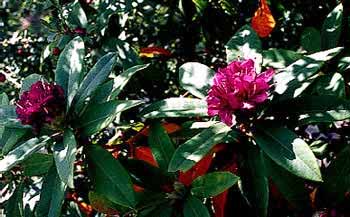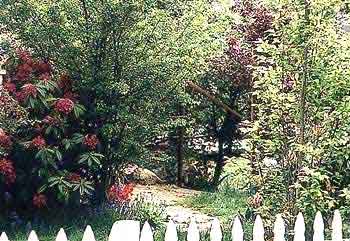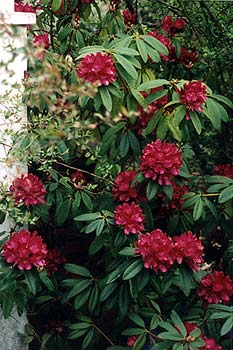 | |
| In this portrait, surprisingly taken in October, I like the way the dappled shade falls on these blooms. The shade is from a big hawthorne bush. The rhody & hawthorne grow right over the edge of the porch & the hawthorne especially demands to be cut back now & then since it's so stabby. The third photo below was taken in late April, the middle view in May. | |
'Lee's Best Purple'
Reblooms Each Autumn!
"If you pass by the color purple in a field & don't notice it, God gets real pissed off."
-Alice Walker
This old rhody impresses me so often, as it gets a full heavy blooming on it twice each year. The first photo was taken in October 2001. Every autumn, it reblooms just as happily & gorgeously as it bloomed in Spring.
When we bought the house, it was such a pleasant suprise our first year here to realize we had one of the rare re-bloomers. It's fortunately located right by the front door, too, so even if Autumn weather's nasty, we can stand on the porch & appreciate this beauty.
Its first blooming time is late April lasting halfway through May. The second picture below shows our seven-foot rhody in its garden setting, photographed in May when its flowers were barely beginning to fade a bit, & the Grape Hyacinths were at the tail-end of their long bloom period; a few of the small blue hyacinth blossoms are visible underneath the big rhody.
 The little tree beside it a hawthorn, & at the foot of the hawthorn you can make out a bright red patch which is a Hino Crimson Azalea. Stage right opposite the dividing path is a hornbeam tree not yet fully leafed. In the background you can make out some purple foliage on a smallish tree; that's a Rohani Beech. Though it's hard to tell from this angle, there's quite a large patch of lawn between all these things, & though I've been tearing out a lot of turf to replace with gardens over time, this particular area will retain a lawn sufficient for our on-the-grass picnics.
The little tree beside it a hawthorn, & at the foot of the hawthorn you can make out a bright red patch which is a Hino Crimson Azalea. Stage right opposite the dividing path is a hornbeam tree not yet fully leafed. In the background you can make out some purple foliage on a smallish tree; that's a Rohani Beech. Though it's hard to tell from this angle, there's quite a large patch of lawn between all these things, & though I've been tearing out a lot of turf to replace with gardens over time, this particular area will retain a lawn sufficient for our on-the-grass picnics.Several Iron Clad rhododendrons do rarely produce an individual shrub that will have a "second bloom" each autumn, but none do so predictably or commonly. When they do so, the blooms persist occasionally through November, in the South the rebloom can be as late as February. But ours blooms April & October, a welcome peculiarity of the individual specimen rather than of the cultivar.
 A few deciduous azaleas rebloom like this, but not so many of the big evergreens. Usually it is a premature blooming of buds that should've waited for the following spring, but our big lepidote blooms densely & fully both times.
A few deciduous azaleas rebloom like this, but not so many of the big evergreens. Usually it is a premature blooming of buds that should've waited for the following spring, but our big lepidote blooms densely & fully both times.When a large evergreen does turn out to be a rebloomer, almost invariably autumn rebloomers are going to be some variety derived from R. catawbiense, the great-grandparent of the vast majority of the classic Iron Clads. One of the most predictable rebloomers is 'Ostbo's Red Elizabeth' which typically blooms a second time at mid-October, but it's practically a dwarf shrub & nothing like our tall & mysterious Iron Clad.
We inherited this tall rhody when we bought the place, & I feared there wasn't much of a chance of ever identifying with certainty the specific variety. The blossoms are a deep magenta-purple coloration with darker freckles on the upper inside of each trumpet. I compared it to 'Anah Kruschke' which is a Catawba & R. ponticum mix, but the funnels are very smooth-edged, whereas this Iron Clad's blooms are slightly ruffled. 'Cynthia' was another possibility known occasionally to have rebloom, but even the darkest pink is not quite magenta-purple, although it too can vary with individualistic specimens.
Comparing it to 'Lee's Dark Purple' in full bloom, I was for a while almost certain this had to be it. It was awfully close to the same blossom in physical appearance, except everyone else's blooms in May & June whereas ours blooms April & May, plus Lee's should have somewhat rippled leaves & ours are barely ribbed. However, 'Lee's Dark Purple' is well-known for some specimens undertaking the autumn rebloom, & it is quite a common shrub. So for several years I always referred to it as "Similar to Lee's Dark Purple."
Eventually I saw the less often offered but similar 'Lee's Best Purple,' & it was a big relief to realize that this early bloomer was in fact the classic cultivar we have! Both 'Lee's Dark' & 'Lee's Best' date to before 1851, even though 'Lee's Best Purple' was not actually registered until 1958. Both are named after a pioneer hybridizer of Hammersmith. Both are notably cold-hardy Catawba hybrids, but 'Lee's Best' is hardiest & can be grown where winters drop to twenty below.
'Lee's Best Purple' is one of the oldest of the Iron Clands, & one of the most robust, & indeed among the most apt to bloom twice in one year even in a temperate microclimate like that of Puget Sound. The lineage of 'Lee's Best' is clouded in time, but is for certain R. catawbiense & possibly pollined by R. maximum.
For more photographs of this shrub, go to the:
'Lee's Best Purple' Page of the Rhododendron Gallery